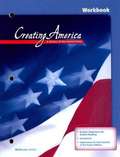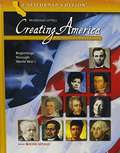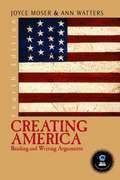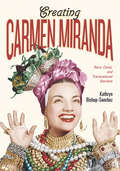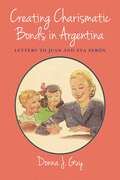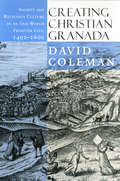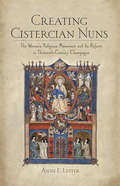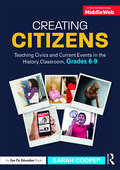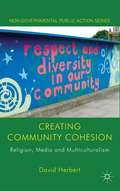- Table View
- List View
Creating America: A History of the United States Workbook
by Mcdougal LittellThis Creating America Workbook contains: Three Worlds Meet, Beginnings to 1763, Creating a New Nation 1763-1791, The Early Republic, 1789-1844, A Changing Nation, 1810-1860, The Nation Divided and Rebuilt, 1846-1877, America Transformed. 1860-1914, Modern America Emerges, 1880-1920, and Depression, War, and Recovery, 1919-1960.
Creating America: A History of the United States, 1877 to the 21st Century
by Donna M. Ogle Jesus Garcia C. Frederick Risinger Joyce Stevos Winthrop D. JordanImagine life in Jamestown, America's first permanent English settlement. The nation we inhabit now is a much different place than it was then, more than three centuries ago. Yet there are repeating themes- ideas and issues- in American history that tie the past and present together. This book focuses on nine significant themes in U.S. history. Understanding these themes will help you to make sense of American history.
Creating America: A History of the United States, Beginnings Through Reconstruction
by Donna M. Ogle Jesus Garcia C. Frederick Risinger Joyce StevosNIMAC-sourced textbook
Creating America: A History of the United States, Beginnings through World War I
by Donna M. Ogle Jesus Garcia C. Frederick RisingerNIMAC-sourced textbook
Creating America: A History of the United States, Beginnings through World War I
by Donna M. Ogle Jesus Garcia C. Frederick Risinger Joyce Stevos Winthrop D. JordanAmericans have always been quick to embrace inventions and new ways of doing things. After all, this country was settled by people who turned away from old ways and tried new ones. In the past two centuries, new inventions, new technologies, and scientific breakthroughs have transformed the United States--and will continue to do so in the new century.
Creating America: A History of the United States, Beginnings through World War I (California Edition)
by Donna M. Ogle Jesus Garcia C. Frederick Risinger Joyce StevosAs the power and prestige of the United States have grown, the nation has played a much more active role in world affairs. Indeed, throughout the 20th century, the United States focused much of its energy on events beyond its borders. The nation fought in two world wars and tried to promote democracy, peace, and economic growth around the globe.
Creating America: A History of the United States- Beginnings Through World War I
by Donna M. Ogle Jesus Garcia C. Frederick RisingerCreating America: Beginnings Through World War I -- A History of the United States
Creating America: Beginnings Through Reconstruction
by Donna M. Ogle Jesus Garcia C. Frederick Risinger Joyce Stevos McDougal-Littell Publishing StaffCreating America: A History Of The United States: Beginnings Through Reconstruction
Creating America: Beginnings through Reconstruction (Texas edition)
by Donna M. Ogle Jesus Garcia C. Frederick Risinger Joyce Stevos Winthrop D. JordanThis book focuses on nine significant themes in U.S. history.
Creating America: Reading and Writing Arguments (Fourth Edition)
by Joyce Moser Ann WattersThematic argument reader with rhetoric (writing guide) on arguments presents selections and images that depict the political and social changes in America from the Revolutionary War to the twenty-first century. Its argumentative focus will teach readers how to persuade others through written words and visual ideas. High Interest topics including 27 new essays, 4 films, and 10 advertisements/pieces of art; information on visual arguments and online research; an in-depth examination of one country's culture within a range of cultures over time. For persuasive writers.
Creating Black Americans: African-American History and Its Meanings, 1619 to the Present
by Nell Irvin PainterHere is a magnificent account of a past rich in beauty and creativity, but also in tragedy and trauma. Eminent historian Nell Irvin Painter blends a vivid narrative based on the latest research with a wonderful array of artwork by African American artists, works which add a new depth to our understanding of black history. Painter offers a history written for a new generation of African Americans, stretching from life in Africa before slavery to today's hip-hop culture. The book describes the staggering number of Africans--over ten million--forcibly transported to the New World, most doomed to brutal servitude in Brazil and the Caribbean. Painter looks at the free black population, numbering close to half a million by 1860 (compared to almost four million slaves), and provides a gripping account of the horrible conditions of slavery itself. The book examines the Civil War, revealing that it only slowly became a war to end slavery, and shows how Reconstruction, after a promising start, was shut down by terrorism by white supremacists. Painter traces how through the long Jim Crow decades, blacks succeeded against enormous odds, creating schools and businesses and laying the foundations of our popular culture. We read about the glorious outburst of artistic creativity of the Harlem Renaissance, the courageous struggles for Civil Rights in the 1960s, the rise and fall of Black Power, the modern hip-hop movement, and two black Secretaries of State. Painter concludes that African Americans today are wealthier and better educated, but the disadvantaged are as vulnerable as ever. Painter deeply enriches her narrative with a series of striking works of art--more than 150 in total, most in full color--works that profoundly engage with black history and that add a vital dimension to the story, a new form of witness that testifies to the passion and creativity of the African-American experience. * Among the dozens of artists featured are Romare Bearden, Elizabeth Catlett, Beauford Delaney, Jacob Lawrence, and Kara Walker * Filled with sharp portraits of important African Americans, from Olaudah Equiano (one of the first African slaves to leave a record of his captivity) and Toussaint L'Ouverture (who led the Haitian revolution), to Harriet Tubman and Sojourner Truth, to Martin Luther King, Jr. and Malcolm X
Creating Canadian English: The Professor, the Mountaineer, and a National Variety of English
by Stefan DollingerThis lively account of the making of Canadian English traces the variety's conceptual, social and linguistic developments from the twentieth century to the present. This book is not just another history of Canadian English; it is a history of the variety's discovery, codification, and eventual acceptance, as well as the contribution of the linguists behind it. Written by an active research linguist focusing on Canadian English, this book is an archive-based biography on multiple levels. Through a combination of new data and re-interpretations of existing studies, a new voice is given to earlier generations of Canadian linguists who, generally forgotten today, shaped the variety and how we think about it. Exploring topics such as linguistic description and codification, dictionary making, linguistic imperialism, linguistic attitudes, language and Canadian identity, or the threat of Americanisation, Dollinger presents a coherent, integrated and balanced account of developments spanning over almost a century.
Creating Carmen Miranda: Race, Camp, and Transnational Stardom (Performing Latin American and Caribbean Identities)
by Kathryn Bishop-SanchezCarmen Miranda got knocked down and kept going. Filming an appearance on The Jimmy Durante Show on August 4, 1955, the "ambassadress of samba" suddenly took a knee during a dance number, clearly in distress. Durante covered without missing a beat, and Miranda was back on her feet in a matter of moments to continue with what she did best: performing. By the next morning, she was dead from heart failure at age 46.This final performance in many ways exemplified the power of Carmen Miranda. The actress, singer, and dancer pursued a relentless mission to demonstrate the provocative theatrical force of her cultural roots in Brazil. Armed with bare-midriff dresses, platform shoes, and her iconic fruit-basket headdresses, Miranda stole the show in films like That Night in Rio and The Gang's All Here. For American film audiences, her life was an example of the exoticism of a mysterious, sensual South America. For Brazilian and Latin American audiences, she was an icon. For the gay community, she became a work of art personified and a symbol of courage and charisma.In Creating Carmen Miranda, Kathryn Bishop-Sanchez takes the reader through the myriad methods Miranda consciously used to shape her performance of race, gender, and camp culture, all to further her journey down the road to becoming a legend.
Creating Carmen Miranda: Race, Camp, and Transnational Stardom (Performing Latin American and Caribbean Identities)
by Kathryn Bishop-SanchezCarmen Miranda got knocked down and kept going. Filming an appearance on The Jimmy Durante Show on August 4, 1955, the "ambassadress of samba" suddenly took a knee during a dance number, clearly in distress. Durante covered without missing a beat, and Miranda was back on her feet in a matter of moments to continue with what she did best: performing. By the next morning, she was dead from heart failure at age 46. This final performance in many ways exemplified the power of Carmen Miranda. The actress, singer, and dancer pursued a relentless mission to demonstrate the provocative theatrical force of her cultural roots in Brazil. Armed with bare-midriff dresses, platform shoes, and her iconic fruit-basket headdresses, Miranda stole the show in films like That Night in Rio and The Gang's All Here. For American film audiences, her life was an example of the exoticism of a mysterious, sensual South America. For Brazilian and Latin American audiences, she was an icon. For the gay community, she became a work of art personified and a symbol of courage and charisma. In Creating Carmen Miranda, Kathryn Bishop-Sanchez takes the reader through the myriad methods Miranda consciously used to shape her performance of race, gender, and camp culture, all to further her journey down the road to becoming a legend.
Creating Charismatic Bonds in Argentina: Letters to Juan and Eva Perón (Diálogos Series)
by Donna J. GuyIn collecting hundreds of letters to Juan and Eva by everyday people as well as from correspondence solicited by Juan Perón, this book promotes a view that charismatic bonds in Argentina have been formed as much by Argentines as by their leaders, demonstrating how letter writing at that time instilled a sense of nationalism and unity, particularly during the first Five Year Plan campaign conducted in 1946. It goes beyond the question of how charisma influenced elections and class affiliation to address broader implications. The letters offer a new methodology to study the formation of charisma in literate countries where not just propaganda and public media but also private correspondence defined and helped shape political polices. Focusing on the first era of Peronism, from 1946 to 1955, this work shows how President Perón and the First Lady created charismatic ways to link themselves to Argentine supporters through letter writing.
Creating Christian Granada
by David ColemanCreating Christian Granada provides a richly detailed examination of a critical and transitional episode in Spain's march to global empire. The city of Granada-Islam's final bastion on the Iberian peninsula-surrendered to the control of Spain's "Catholic Monarchs" Isabella and Ferdinand on January 2, 1492. Over the following century, Spanish state and Church officials, along with tens of thousands of Christian immigrant settlers, transformed the formerly Muslim city into a Christian one. With constant attention to situating the Granada case in the broader comparative contexts of the medieval reconquista tradition on the one hand and sixteenth-century Spanish imperialism in the Americas on the other, Coleman carefully charts the changes in the conquered city's social, political, religious, and physical landscapes. In the process, he sheds light on the local factors contributing to the emergence of tensions between the conquerors and Granada's formerly Muslim, "native" morisco community in the decades leading up to the crown-mandated expulsion of most of the city's moriscos in 1569-1570. Despite the failure to assimilate the moriscos, Granada's status as a frontier Christian community under construction fostered among much of the immigrant community innovative religious reform ideas and programs that shaped in direct ways a variety of church-wide reform movements in the era of the ecumenical Council of Trent (1545-1563). Coleman concludes that the process by which reforms of largely Granadan origin contributed significantly to transformations in the Church as a whole forces a reconsideration of traditional "top-down" conceptions of sixteenth-century Catholic reform.
Creating Cistercian Nuns: The Women's Religious Movement and Its Reform in Thirteenth-Century Champagne
by Anne E. LesterIn Creating Cistercian Nuns, Anne E. Lester addresses a central issue in the history of the medieval church: the role of women in the rise of the religious reform movement of the thirteenth century. Focusing on the county of Champagne in France, Lester reconstructs the history of the women’s religious movement and its institutionalization within the Cistercian order.The common picture of the early Cistercian order is that it was unreceptive to religious women. Male Cistercian leaders often avoided institutional oversight of communities of nuns, preferring instead to cultivate informal relationships of spiritual advice and guidance with religious women. As a result, scholars believed that women who wished to live a life of service and poverty were more likely to join one of the other reforming orders rather than the Cistercians. As Lester shows, however, this picture is deeply flawed. Between 1220 and 1240 the Cistercian order incorporated small independent communities of religious women in unprecedented numbers. Moreover, the order not only accommodated women but also responded to their interpretations of apostolic piety, even as it defined and determined what constituted Cistercian nuns in terms of dress, privileges, and liturgical practice. Lester reconstructs the lived experiences of these women, integrating their ideals and practices into the broader religious and social developments of the thirteenth century—including the crusade movement, penitential piety, the care of lepers, and the reform agenda of the Fourth Lateran Council. The book closes by addressing the reasons for the subsequent decline of Cistercian convents in the fourteenth century. Based on extensive analysis of unpublished archives, Creating Cistercian Nuns will force scholars to revise their understanding of the women’s religious movement as it unfolded during the thirteenth century.
Creating Citizens: Teaching Civics and Current Events in the History Classroom, Grades 6–9
by Sarah CooperEngage students in meaningful civic learning and encourage them to become active and informed citizens. With this essential book, co-published by Routledge and MiddleWeb, you will gain a variety of practical strategies for teaching civics and current events to your middle school students. Author and expert teacher Sarah Cooper takes you into her school and shares her classroom-tested methods and tools.Topics include: Fitting current events into an already-packed history curriculum Staying nonpartisan and fostering balanced discussions Helping students find their stake in the news Teaching civic literacy through primary sources, then and now Encouraging students to invest in analytical writing Fostering student ownership of our classrooms through discussion and debate Cultivating citizenship through empathy and community engagement Throughout the book, you’ll find student examples, handouts, and rubrics, so that you can easily implement the ideas in your own classroom. By getting your students to think critically about current events, you will help them become passionate writers, thinkers, and involved citizens.
Creating Citizenship in the Nineteenth-Century South
by William A. Link, David Brown, Brian Ward and Martyn Bone"This is a remarkable collection of essays. Citizenship clearly forms the backbone for these investigations but the range of the contributors’ backgrounds (in terms of disciplinary training) and the approaches they take to the question makes this collection both broad and deep. As it turns out, there is no other way to tackle a concept as central but also as slippery as citizenship. A shorter or more focused collection would miss the nuances and insights that this one offers."—Aaron Sheehan-Dean, author of Why Confederates Fought: Family and Nation in Civil War Virginia "President Obama’s citizenship continues to be questioned by the ‘birthers,’ the Cherokee Nation has revoked tribal rights from descendants of Cherokee slaves, and Parliament in the U.K. is debating ‘citizenship education.’ It is in both this broader context and in the narrower academic one that Creating Citizenship in the Nineteenth-Century South stands as a smart, exciting, and most welcome contribution to southern history and southern studies."—Michele Gillespie, author of Katharine and R.J. Reynolds: Partners of Fortune and the Making of the New South "Combining historical and cultural studies perspectives, eleven well-crafted essays and a provocative epilogue engage the economic, political, and cultural dynamics of race and belonging from the era of enslavement through emancipation, reconstruction, and the New South."—Nancy A. Hewitt, author of Southern Discomfort More than merely legal status, citizenship is also a form of belonging, shaping individual and group rights, duties, and identities. The pioneering essays in this volume are the first to address the evolution and significance of citizenship in the American South during the long nineteenth century. They explore the politics and contested meanings of citizenry from a variety of disciplinary perspectives in a tumultuous period when slavery, Civil War, Reconstruction, and segregation redefined relationships between different groups of southern men and women, both black and white.
Creating Colonial Pasts
by Cecilia MorganCreating Colonial Pasts explores the creation of history and memory in Southern Ontario through the experience of its inhabitants, especially those who took an active role in the preservation and writing of Ontario's colonial past: the founder of the Niagara Historical Society, Janet Carnochan; twentieth-century Six Nations historians Elliott Moses and Milton Martin; and Celia B. File, high-school teacher and historian of Mary Brant.Examining the grand narratives of colonial Ontario - the Loyalists, the War of 1812, and the creation of settler society - Cecilia Morgan argues that place played an important role in shaping memory and narrative in locations such as Niagara-on-the-Lake, the Six Nations territory at the Grand River, and the Mohawk community at Tyendinaga. Illuminating the pivotal role of women and Indigenous people in historical commemoration and uncovering the existence of a lively and interconnected circle of historians and heritage activists in late nineteenth and twentieth-century Ontario, Creating Colonial Pasts is a virtuoso study of history-making.
Creating Colonial Williamsburg: The Restoration of Virginia's Eighteenth-Century Capital
by Anders GreenspanIn Creating Colonial Williamsburg, Anders Greenspan examines the restoration and re-creation of the structures and gardens of Virginia's colonial capital beginning in 1926. The restoration was undertaken by the Rockefeller family, whose aim was to promote a twentieth-century appreciation for eighteenth-century ideals. Ironically, those ideals, including democracy, individualism, and representative government, were often promoted at the expense of a more complete understanding of the town's true history. The meaning and purpose of Colonial Williamsburg has changed over time, along with America's changing social and political landscapes, making the study of this historic site a unique and meaningful entry point to understanding the shifting modern American character.In recent years, financial struggles and declining attendance forced a new interpretation of the town, extending the presentation into the period of the American Revolution, while adding new interpretive approaches such as street theater and a greater emphasis on technology. Over its eighty-year history, says Greenspan, Colonial Williamsburg has grown and matured, while still retaining its emphasis on the importance of eighteenth-century values and their application in the modern world.
Creating Community Cohesion
by David HerbertUsing approaches from sociology, media and religious studies, David Herbert compares recent public controversies involving or implicating religion in the UK (England and Northern Ireland), the Netherlands and France.
Creating Connecticut: Critical Moments That Shaped a Great State
by Walter W. WoodwardConnecticut State Historian Walter Woodward helps us understand how people and events in Connecticut&’s past played crucial roles in forming the culture and character of Connecticut today. Woodward, a gifted story-teller, brings the history we thought we knew to life in new ways, from the nearly forgotten early presence of the Dutch, to the time when Connecticut was New England&’s fiercest prosecutor of witches, the decades when Connecticans were rapidly leaving the state, and the years when Irish immigrants were hurrying into it. Whether it&’s his investigation into the unusually rough justice meted out to Revolutionary War hero Nathan Hale, or a peek into Mark Twain&’s smoking habits, Creating Connecticut will leave you thinking about our state&’s past––and its future––in a whole new way.
Creating Consumers
by Carolyn M. GoldsteinHome economics emerged at the turn of the twentieth century as a movement to train women to be more efficient household managers. At the same moment, American families began to consume many more goods and services than they produced. To guide women in this transition, professional home economists had two major goals: to teach women to assume their new roles as modern consumers and to communicate homemakers' needs to manufacturers and political leaders. Carolyn M. Goldstein charts the development of the profession from its origins as an educational movement to its identity as a source of consumer expertise in the interwar period to its virtual disappearance by the 1970s.Working for both business and government, home economists walked a fine line between educating and representing consumers while they shaped cultural expectations about consumer goods as well as the goods themselves. Goldstein looks beyond 1970s feminist scholarship that dismissed home economics for its emphasis on domesticity to reveal the movement's complexities, including the extent of its public impact and debates about home economists' relationship to the commercial marketplace.
